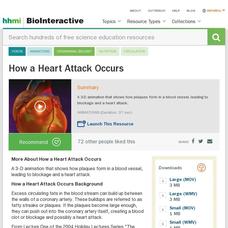Curated Video
Blood Typing Using the Eldon Blood Typing Kit
What blood type do you have? Is it A, B, AB, or O. And are you RhD positive or negative. In this video, you will learn how to use the Eldon Blood Typing Kit to determine your blood type at home.
Curated Video
Endocrine System, part 1 - Glands & Hormones: Crash Course A&P
Hank begins teaching you about your endocrine system by explaining how it uses glands to produce hormones. These hormones are either amino-acid based and water soluble, or steroidal and lipid-soluble, and may target many types of cells...
Mr. R.'s Songs for Teaching
Bones! Learn the bones of the human body!
I song I wrote for my anatomy classes to help learn the names and function of the bones in the human body! Purchase song on iTunes: https://goo.gl/nBcqhB LYRICS: Bones, bones, bones, That's our skeleton! Bones, bones, bones, That's our...
Kids Learning Videos
Mammals - Learn about mammals for kids
Mammals! This video teaches children about mammals. There are many different types of mammals on the earth, including horses, dolphins and giraffes. Mammals are warm blooded animals that have a back bone. Thanks for watching this video...
Clarendon Learning
All About Fish for Kids | Learn the characteristics of Fish | What is a Fish?
What is a fish? If you're not sure, in this video we will learn all about fish for kids! We start by identifying the important characteristics of fish like being vertebrates, being cold-blooding, having gills, etc. We then look into the...
Clarendon Learning
Mammals For Kids | Learn all about the unique characteristics of mammals and what mammals are!
Mammals for kids is a fun engaging video that will help students learn all about the characteristics of mammals and what mammals really are! We quickly introduce animal classification and the difference between the types of animals but...
Crash Course
Blood – True Blood (Part 1)
Teach your class about human blood and explain why donation is so important using the 29th video in a series of 47. Learners explore the basic components of blood, how cuts stop bleeding, and how antigens determine blood types.
Crash Course
Blood – There Will Be Blood (Part 2)
Since 2004, blood doping in cycling has dropped by 50 percent. The video opens with a narration about blood doping and then focuses on the structure of blood and how its parts work to keep the body alive. Classes learn about the...
Amoeba Sisters
Specialized Cells: Significance and Examples
All cells are created equal, but some go on to do amazing things! Find out more about these super hero cells with a short video from a well-written biology playlist. Topics include specialized plant and animal cells and how cells know to...
Crash Course
Tissues (Part 1)
Once a nerve cell is damaged, it cannot be reproduced. Video number two in a series of 47 introduces high schoolers to tissues, focusing on the four types: nervous, muscle, epithelial, and connective. The narrator teaches their roles in...
Crash Course
The Skeletal System
Humans have 54 bones in their hands, fingers, and wrists, allowing for a variety of movement. The 19th video in a series of 47 introduces learners to the anatomy of the skeletal system. The narrator teaches about flat, short, and...
Amoeba Sisters
Homeostasis and Negative/Positive Feedback
We all need a little feedback, both positive and negative! Take on one of the trickier Biology 1 concepts using a thoughtfully worded video from a fantastic biology playlist. The narrator explains both types of feedback with plenty of...
Crash Course
The Integumentary System – Skin Deep (Part 1)
Every minute, your skin sheds more than 30,000 dead skin cells. The sixth video of 47 teaches pupils about the three layers of skin, their composition, and different cell types. It takes a trip through the layers to help individuals...
Crash Course
Urinary System (Part 1)
Explore the urinary system with your class using the 38th video in a series of 47 on the human body. The narrator teaches about the anatomy, the functions of each organ, and how this system filters blood to get rid of waste and form urine.
Crash Course
The Nervous System – Action! Potential! (Part 2)
There are about 100,000 chemical reactions happening in your brain every second to help you sense and respond to the world around you. After a brief review of electricity, the narrator explores the action potential neurons used to sense...
Crash Course
Tissues – Epithelial Tissue (Part 2)
Epithelial tissues plays a variety of roles in the human body, including covering, lining, making a barrier, protection, excretion, filtration, absorption, and sensation. The video teaches high schoolers about epithelial tissue and its...
Crash Course
The Nervous System (Part 1)
If you line up all of the neurons in your body, they would stretch almost 600 miles! The seventh video in a series of 47 and explore the nervous system, both central and peripheral. The narrator teaches the organization and composition...
Crash Course
Reproductive System – Female Reproductive System (Part 1)
Pupils learn about menstruation and the female reproductive system in the 40th video of 47. Beginning with the anatomy and moving into hormones and ovulation, the narrator teaches an abundance of vocabulary and information regarding...
American Chemical Society
Chameleons Are Masters of Nanotechnology
The oddball reptiles, chameleons, can teach animal lovers a little something about nanotechnology. Viewers peel away the layers of the chameleon skin to discover the different types of chromatophores using an episode of a larger series...
Howard Hughes Medical Institute
How a Heart Attack Occurs
Heart disease causes more deaths in both men and women in the United States than any other factor, buy many people don't fully understand what causes a heart attack. A brief animation demonstrates the slow buildup of plaque, a blockage...



















